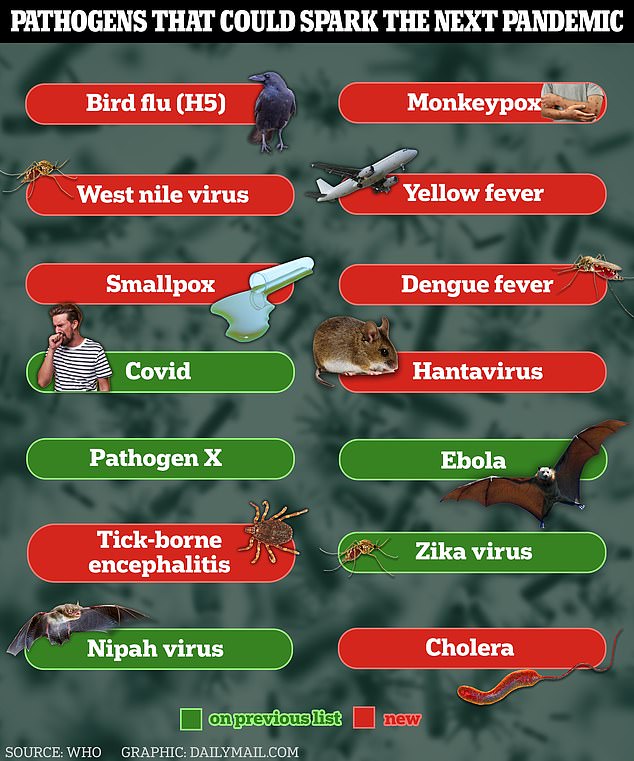The World Health Organization has revealed its list of more than 30 pathogens that are most likely to cause the next pandemic.
Among the most dangerous viruses and bacteria is the H5N1 bird flu, which is spreading in the United States and which scientists fear could easily mutate and be transmitted between humans.
There are also fears about mosquito-borne dengue fever, sometimes called the “bone-breaking disease,” which is also spreading in the United States at record levels.
And monkeypox, which caused a global epidemic in 2022, was also on the list, amid an outbreak of a deadlier and more infectious strain in Africa.
The above shows a selection of pathogens included in the list that researchers considered to have a “high” likelihood of causing the next major pandemic or outbreak.
More than half of the entries were new compared to the 2017 list, when it was first published.
It also included hantavirus, a virus that spreads among rodents, West Nile virus transmitted by mosquitoes, influenza and Covid.
Scientists also added smallpox, although it is now eradicated, out of fear that it could be accidentally released in a laboratory accident and then spread rapidly because few people now have immunity to the virus.
And Lassa fever, transmitted by rodents, can cause bleeding from the gums, eyes and nose and seizures in patients.
The list was compiled by 200 scientists from more than 50 countries after reviewing a shortlist of 1,600 bacteria and viruses.
Strains flagged as having “pandemic potential” were highly transmissible and virulent (or capable of causing severe disease in humans).
The most dangerous diseases were also those for which there were no vaccines or treatments available to patients.
Previously, the 2017 and 2018 lists only included about a dozen pathogens.

The list was updated due to climate change, deforestation and the growth of international travel, which can make other diseases more likely to cause a new outbreak (stock)
| Disease | Latin name | Risk level |
|---|---|---|
| Lassa fever Argentine Hemorrhagic Fever Anger Plague Shigellosis Salmonella Pneumonia MERS; Middle East respiratory virus SARS; Severe acute respiratory syndrome Ebola Marburg virus Zika virus Dengue Yellow fever Tick-borne encephalitis West Nile Virus Hantavirus Crimean-Congo haemorrhagic fever Avian flu (H1 to H10) Swine flu (H1 to H3) Nipah virus SFTS fever Rift Valley Fever Smallpox Smallpox virus Monkeypox Chikungunya virus Venezuelan equine encephalitis Pathogen X Adenovirus Adenovirus 14 Hand, foot and mouth Lentivirus Borna disease virus Hepatitis C Hepatitis E HerpesHPVParvovirus | Mammarenavirus lassaense Mammarenavirus juniense Vibrio Cholerae Serotype 1 Yersinia pestis Shigella dysenteriae Salmonella enterica Klebsiella pneumoniae Subgenus Merbecovirus Subgenus Sarbecovirus Zairian orthoebolavirus Sudanese orthoebolavirus Orthoebolavirus zikaense Dengue orthoflaviviridae Orthoflaviviridae flavi Orthoflaviviridae encephalitis Orthoflaviviridae nilense Unnamed Orthohantavirus Orthonairovirus haemorrhagiae Influenza alpha virus Influenza alpha virus Henipavirus nipahense Bandavirus dabienense Rift phlebovirus Variola orthovirus Orthovirus vaccine Orthovirus monkeypox Chikungunya alphavirus Venezuelan alphavirus Pathogen X Recombinant mastadenovirus Mastadenovirus blackbeardi serotype 14 Coxsackiepol enterovirus Lentivirus humimdef1 Bornean orthobornavirus Orthohepadnavirus hominoidei C Paslahepevirus balayani 3 HerpesviridaePapillomaviridaeCarnivorous protoparvovirus | HIGH HIGH HIGH HIGH HIGH HIGH HIGH HIGH HIGH HIGH HIGH HIGH HIGH HIGH HIGH HIGH HIGH HIGH HIGH HIGH HIGH HIGH HIGH HIGH HIGH HIGH HIGH HIGH HIGH medium low medium low half half low low low lowlowlow |
But now researchers have expanded the list amid more opportunities for diseases to spread from animals to humans and between areas of the world.
Urbanization and deforestation have boosted contact between wildlife and humans, scientists said, while more international travel creates new opportunities for a disease to reach new areas of the world.
There are also concerns that climate change could fuel an outbreak by causing diseases to spread to new areas.
Dr. Ana Maria Henao Restrepo, who led the report, said Nature“The prioritization process helps identify critical knowledge gaps that need to be urgently addressed.”
Other diseases also included in the report were five bacteria, including cholera, which can cause stomach upset, and Yersinia pestis, the bacterium responsible for plague.
Among those remaining on the list was also the bat-borne Nipah virus, which can cause severe inflammation of the brain.
Many of the diseases on the list have only been diagnosed in sporadic cases so far.
But researchers warned that if they acquired mutations that allowed them to spread better between people, they could trigger an outbreak.
Most diseases are transmitted by ticks, bats, mosquitoes, rodents or people, and are often spread through respiratory droplets.
To become a pandemic, a virus or bacteria must spread among humans, be detected worldwide and cause disease.


